
Colin McRae Rally 3
Written by: Rik
Date posted: April 29, 2020
- Genre: Racing
- Developed by: Codemasters
- Published by: Codemasters
- Year released: 2003
- Our score: 7
I recently bought a new external hard drive and I must admit to thinking that the purchase wouldn’t perhaps have been necessary if I didn’t insist upon keeping quite such an extensive archive of bland and largely identical screen grabs from various 00s rally games on my existing storage devices. Still, the truth is, we haven’t even scratched the surface in terms of our coverage on FFG, and to date we’ve only looked at one entry from the flagship Colin McRae series, some years ago now.
Thinking about it now, gaming endorsements from a single named celebrity seem like a relic of the 80s and 90s, and it does seem like an odd way to promote a product, particularly as (back then) the person in question was extremely unlikely to know about or have any interest in games at all. Occasionally a contractually-obliged quote would be attributed to the big name in question (“It’s just like the real thing!” or something similar) but most of the time the name, a picture, and perhaps an autograph for the box would be sufficient.
Last time, your correspondent did Mr McRae a disservice by implying that this was indeed the nature of his relationship with the series of games bearing his name, and in fact I soon learned (shortly after the sad news of his death, which gave me even more cause to regret the flippant tone taken) that he did in fact have some hands-on involvement during development, and provided valuable feedback to the programming team. Mea culpa, sincere apologies etc. I bet Brian Lara’s never played his cricket games though. [You just don’t learn, do you – FFG reader].
The McRae series was the undisputed king of console rallying during the original PlayStation era, and this success translated well to the PC, although it did come up against significantly stronger opposition from titles not released on console that were free to make use of the PC’s extra processing power. This third effort marks the transition to the PS2/Xbox generation, and although a fan of racing games and a PS2 owner during this period, I never got around to the series on console. Instead, I followed the time-honoured tradition of buying it later on PC for pennies with vague thoughts of playing it one day, only to leave it on a shelf for years.
Still, for some games, “one day” does come eventually, and in this case nostalgic feelings were stirred sufficiently by a recent anniversary to prompt the box to be sought out and dusted off. (And, to be fair, I had previously noted some pretty nice windscreen wiper action in screenshots, which is a niche interest of mine, and I’m pleased to report that not only is the visual effect very nice, but it’s also accompanied by some very satisfying wiper motor noises [Get help – FFG reader] –although, as became the trend at some point, the in-car view is next to useless when it comes to actually playing the game).
Unlike in previous games in the series, in Colin McRae Rally 3, you actually have to be Colin in order to attempt the main career mode. In other words, you are forced to play as McRae, alongside then co-driver Nicky Grist (although not for much longer after this game: in, fact by the time the PC version came out, some months after the console release, they had already parted ways) in his 2002 Ford Focus RS WRC, and other cars can be used in the single-stage area of the game only. This was a source of some controversy at the time, with racing fans traditionally used to a choice of vehicle upset at this being taken away, and Codemasters defending the move by saying it allowed them to provide a more authentic experience, particularly with regard to accurate performance and damage modelling.
Personally, I didn’t mind too much. It does at least make things simple: no fiddling about with different cars and setups to find out which one you like best, and no questioning whether it’s you or the car that’s responsible for poor performance. The structure of the career mode sees you undertake three consecutive seasons of World Rally Championship action. If you manage to win the Championship then the difficulty level goes up a notch, and then at the end of the three years you get a grade for your overall performance. Each season involves six rallies (from a total of eight featured in the game) consisting of six stages each, plus a final super special stage in a stadium which sees you go head to head with your closest opponent in that rally’s standings. Otherwise, though, it’s you and the Focus against the course, and the clock.
You can adjust different aspects of the car’s setup and test these settings during the shakedown/testing period, although if you’re not a fan of such things then it’s not laid on too thick, and the defaults should be fine, at least to start with. My own perspective is that I’d rather avoid this whole area, by choice, but if forced to do so and sufficiently engaged by the game, then I will. Here, I didn’t particularly feel so-inclined: mechanical tinkering seems to be about marginal gains and my main setbacks were more substantive: namely, failing to keep the car on the road or avoid dangerous obstacles. (Of course, you may argue that you have a better chance in those areas if you set the car up correctly, but I doubt that was the issue here).
Anyway, driving indeed proved to be a big challenge at first, with my struggles with the rather slippery handling causing serious damage both to the car and my chances of competitive stage times (with rage-induced wheelspins in the bushes frequently causing even more vital seconds to be lost). At times, the road seems almost impossibly narrow and the handling lacking enough nuance to negotiate certain courses successfully.
The previous McRae title, 2.0, seemed fairly hemmed in, which is admittedly a feature of real rally racing, but graphically it suffered in comparison to the open vistas of the likes of Rally Championship Xtreme and Rally Trophy. However, although there are some narrow courses here, with the extra power of the next generation of consoles to play with, there’s a lot more scenery to take in this time, making it feel more like you’re driving through a particular country than racing on a themed track. That said, some of the scenery is a bit flat and disappointing, and there are times when it looks like a PS2-era car racing around PS1-era courses. When you consider that Codemasters’ own TOCA Race Driver was released around the same time, CMR3 does seem a bit lacking visually in comparison.
Unlike circuit-based racing, rallying is more about getting through unscathed as it is about precision and perfection: not crashing regularly is a reasonable first goal, and a more than adequate strategy for winning the championship at the initial difficulty level. I’m not sure if there is a defined order of challenge as such when it comes to the individual rallies, but my experience varied from those that seemed a breeze, relatively speaking (Finland) to rallies that were very hard at first but ultimately possible to do well in (Sweden) to ones in which I found myself so far off the pace that I couldn’t imagine ever winning (UK, Japan).
Within the confines of an accessible and non-simulation-based approach, CMR3 does seem like a more technical game than other rally titles I’ve played and enjoyed, and maintaining the correct technique seems crucial to success, particularly as the difficulty levels ramp up. In the snow of Sweden, for example, if you let your front wheels go into the deep stuff, your car’s going to spin. If it does, it’s best not to panic and hit the steering or throttle too hard to try and correct things, because that’ll only make it worse.
That kind of thing, I managed to understand and overcome: on the other hand, racing on tarmac seemingly requires you to be really aggressive in a way that I simply couldn’t fathom or master: being more tentative and careful reduced the frequency of mistakes but left me well off the pace; while really going for it led to more damage and even worse stage times.
Speaking of which, damage does impact your performance, and although it is implemented in a relatively forgiving way, and you’re saved from retirement after dropping off the side of a hill or driving into a river, persistent carelessness does stack up. I only managed only one tyre blow-out throughout my career, after driving into a kerb at high speed, but racing on the bare wheel for the bulk of the stage also seemed eminently possible and I daresay that doing so didn’t even produce my worst attempt at that particular stage. Damage to bodywork is a more immediate and present threat than problems with the internal workings of your car, although I took my traditional cowardly option of automatic gears, and potentially a manual gearbox comes with additional complications in this regard.
Three seasons felt like enough to me, even though I only achieved the second of the three difficulties (hard) and was well back from the leading drivers by the end of that season. It was broadly enjoyable stuff, although the feeling of wrestling the car never quite goes away. With racers, the most satisfying times are when you’re in the zone of concentration, knowing what you need to do and when, and the time-trial nature of events in rally games also means that there are no daft AI issues to take you out of that bubble. In CMR3, there were moments when I really felt like I was there, and others where I definitely wasn’t. Although I tried to avoid doing so, I must admit to harking back again to Rally Championship Xtreme, which may lack some of the authenticity, and certainly the detailed car setup and modelling, on offer here, but captures more of a low-key sense of exploration and plotting a course through vast landscapes, that I still find appealing.
This game got a little bit of stick at the time of release, and two subsequent follow-ups in successive years, adding features identified as ‘missing’ here, was interpreted by some as a tacit admission by Codemasters that this one wasn’t perhaps all it should be. They don’t tend to make bad games though, and the series is still going strong, thanks to a late 00s revamp in the form of Colin McRae: Dirt, and the more recent Dirt Rally. For what it’s worth, I’d accept some contemporary criticism of this third game, particularly regarding the graphics, as valid, but I wasn’t all that bothered about the focus on the, er, Focus during career mode. Overall, it represents a good step up from its predecessor, and still holds up pretty well.

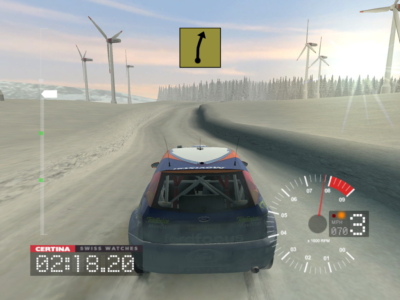
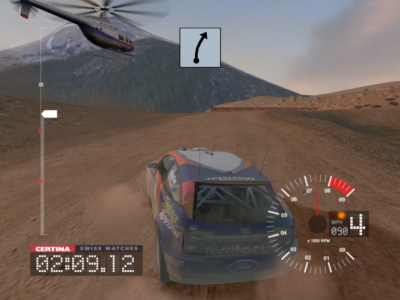
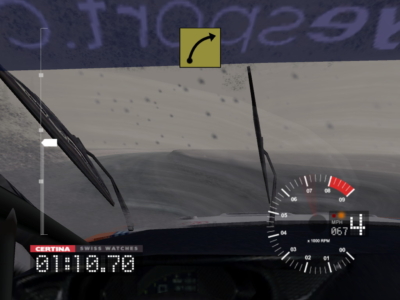
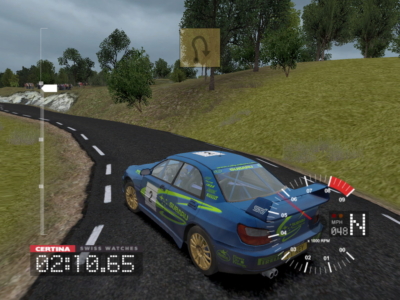
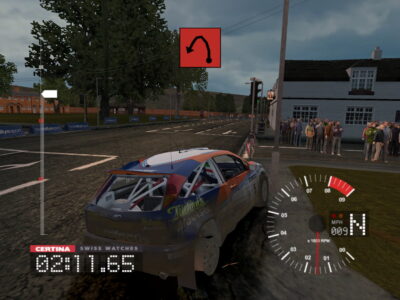
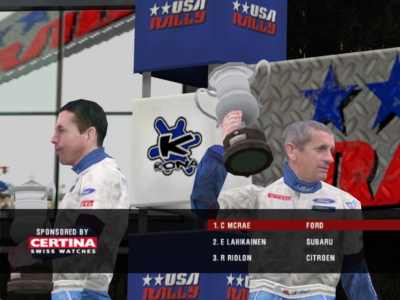

 Posts
Posts
How much of rally driving is reactionary? When your co-driver calls out “soft left” or whatever – and I’m assuming the icons in the screenshots match that – do you know exactly what is coming up from that? Roughly? Are you still cresting hills, looking at the track ahead, going “whhohaoooOOOAAA” and correcting?
I guess I’m trying to understand the appeal of a rally game over a circuit game, having no experience with rally games. I feel like most of circuit racing is learning the track, while that doesn’t happen in rally?
May 7, 2020 @ 4:41 am
As far as I understand it, in real rallying, the driver and co-driver are allowed an initial ‘recce’ drive of a stage to put together their pace notes (i.e. what the co-driver will call out) but that’s all. So while there is some preparation and prior knowledge, it’s not to anything like the same extent as in circuit-based racing.
From a gaming point of view I quite like that because it sort of allows you to jump in and get on with it. You do get better with practice but not by trying to commit stages to memory. The racing itself is based on a combination of your own judgement in the here and now while also bearing in mind the notes from your co-driver about what’s coming up, mirrored by the on-screen symbols as a visual aid, although there’s extra detail in the comments themselves, for example ‘don’t cut’ means ‘don’t cut this corner, you’ll probably hit a tree or a big rock’.
(I should add that ‘jump in and get on with it’ probably only applies to the more accessible end of the market and not the more hardcore sims that place more importance on setting up the car and proper driving technique).
May 7, 2020 @ 7:36 am
Makes sense. I thought only the co-driver got to do a practice run and the driver had to go in cold. Which sounds like how you’re able to play it in games, but maybe not the most realistic.
If money were no object, how far would you go on the simulation side? USB wheel and shifter? All the way up to three monitors and rumbly seat?
May 7, 2020 @ 1:43 pm
I think I’m comfortable with accessible arcade/sim hybrids that you can play with a pad, to be honest. I usually stick with automatic shift and most of the cowardly options turned on.
I once bought a wheel and pedals for my PS1 in the hope they would help me enjoy Gran Turismo a little more, but I didn’t really have room for them and that wasn’t really my problem in the first place!
May 7, 2020 @ 2:46 pm